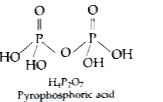(a) Account for the following :
(i) Tendency to show - 2 oxidation state decreases from oxygen to tellurium.
(ii) Acidic character increases from HF to HI.
(iii) Moist SO2 gas acts as a reducing agent.
(b) Draw the structure of an oxoacid of phosphorus containing P - 0 - P linkage.
(c) Complete the following equation :
XeF2+H2O→
OR
(a) Among the hydrides of group 16, write the hydride
(i) which is a strong reducing agent ?
(ii) which has maximum bond angle ?
(iii) which is most thermally stable ?
Give suitable reason in each.
(b) Complete the following equations :
AgNO3+H2O+H3PO2→
(c ) CI2+N(Cold and dilute)aOH→
(a) (i) As we move from top to bottom in group 16, the metallic character increases. Thus Te behaves as a metal. It has no tendency to gain the electrons. Thus, its tendency to show - 2 oxidation state decreases.
(ii) Bond length between Hand the halogen increases as we move from F to I. Thus, hydrogen is less strongly bonded to halogen and is available for reduction.
(iii) It gets oxidised to sulphuric acid and therefore acts as a reducing agent.
SO2+H2O+O→H2SO4+O
(b) 
(c ) 2XeF2+2H2O→2Xe+4HF+O2
OR
(a) (i) H2Te is the strongest reducing agent because the thermal stability is the minimum.
(ii) H2O has the maximum bond angle of 104.5°. As the size of group 16 element increases down the group, the electronegativity decreases. Group 16 element is not able to hold the lone pair of electrons to itself and lone pair-lone pair repulsions increase. Therefore H2O has the maximum angle and H2Te the minimum angle.
(iii) H2O is thermally most stable because it has the maximum enthalpy of dissociation.
(b) AgNO3+H2O+H3PO2→4Ag+4HNO3+H3PO4
(c ) CI2+2NaOHCold and−−−−−−−→diluteNaCI+NaCIO+H2O
Topper's Solved these Questions
- CBSE EXAMINATION PAPER 2020 (CODE No.56/4/1) BOOK - U-LIKE SERIESCHAPTER - CBSE EXAMINATION PAPER 2020 (CODE No.56/4/1) EXERCISE - SECTION -C
7 Videos
- CBSE EXAMINATION PAPER 2020 BOOK - U-LIKE SERIESCHAPTER - CBSE EXAMINATION PAPER 2020 EXERCISE - SECTION D
6 Videos
- CHEMICAL KINETICS BOOK - U-LIKE SERIESCHAPTER - CHEMICAL KINETICS EXERCISE - SELF ASSESSMENT TEST (SECTION D)
1 Videos
Similar Questions
Account for the following:
Tendency to show -2 oxidation state diminishes from sulphur to polonium in Group 16.
View SolutionComplete the following equations :
XeF4+H2O→
XeF2+PF5→
XeF6+NaF→
View SolutionBalance the following equation : XeF6+H2O→XeO2F2+HF
View SolutionComplete the following chemical equation :
(i) P4+NaOH+H2O→
(ii)XeF4+O2F2→
View Solution(a) complete the following chemical equation :
(i) P4+NaOH+H2O→
(ii)XeF4+O2F2→
View SolutionComplete the following chemical reaction equations :
(i) XeF2+H2O→
(ii) PH3+HgCl2→
View SolutionComplete the following chemical reaction equations :
(i) XeF2+H2O→
(ii) PH3+HgCl2→
View SolutionAccount for the following:
Acidic character decreases from N2O3 to Bi2O3 in group 15.
View Solutioncomplete the following equation :
(i) c+conc.H2SO4→
(ii) XeF2+H2O→
View Solutioncomplete the following equation :
(i) c+conc.H2SO4→
(ii) XeF2+H2O→
View Solution
